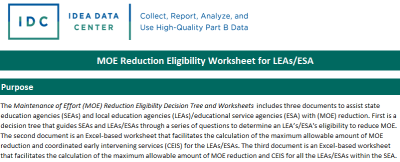Site Search
Results 1 - 7 of 25
Format: Presentations
Identified Significant Disproportionality – Now What?After a State determines that a district has significant disproportionality, what are the next steps? Presenters and session participants discussed how states can identify technical assistance and available tools and resources to help LEAs identify root causes and implement action steps, including CEIS, to make substantive improvement.
Format: Presentations
The Power of Data: Leveraging the Role of Data Managers to improve ResultsThis session examined the strategic role data play in state agency decision making by exploring how data managers can more effectively use their role to promote public reporting, data awareness, data utilization, and systems change. Presenters paid particular attention to data governance, cross-department information sharing, timely data access, distribution, usability, and analysis, along with examples of best practice from practitioners in the field to ultimately improve student results.
Format: Guides and Briefs
Navigating Voluntary Coordinated Early Intervening Services (CEIS)This technical assistance document focuses on helping SEAs and LEAs better understand voluntary CEIS and its reporting requirements. It also provides examples of various data collection and reporting methods states use to collect and report voluntary CEIS data.
Format: Guides and Briefs
Navigating Coordinated Early Intervening Services (CEIS) Frequently Asked Questions (FAQ)This FAQ document focuses on helping SEAs and LEAs understand CEIS and its reporting requirements. SEAs and LEAs can use the resource in conjunction with the OSEP Guidance Memo 08-09.
Format: Presentations
A Review of State Approaches to IDEA Reporting Coordinated Early Intervening Service (CEIS)IDEA allows, and sometimes requires, LEAs to use funds provided under Part B of IDEA for CEIS for students who are not receiving special education services. There are multiple data collection and reporting requirements associated with the use of these funds for CEIS. IDC staff review how a diverse subset of states and their LEAs are working to meet those requirements. Both aggregate and student-level reporting approaches are reviewed.
Format: Applications and Spreadsheets
Maintenance of Effort (MOE) Reduction Eligibility Decision TreeThe Maintenance of Effort (MOE) Reduction Eligibility Decision Tree guides SEAs and LEAs/ESAs through a series of questions to determine an LEA’s/ESA's eligibility to reduce MOE.
Format: Applications and Spreadsheets
Maintenance of Effort (MOE) Reduction Eligibility WorksheetsThe Maintenance of Effort (MOE) Reduction Eligibility Worksheets includes two documents to assist SEAs and LEAs/ESAs with MOE reduction. The first is an Excel-based worksheet that facilitates the calculation of the maximum allowable amount of MOE reduction and CEIS for the LEA/ESAs. The second document is an Excel-based worksheet that facilitates the calculation of the maximum allowable amount of MOE reduction and CEIS for all the LEAs/ESAs within the SEA.








